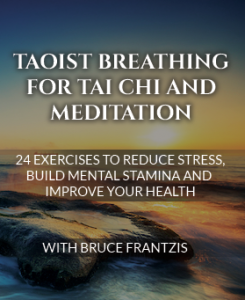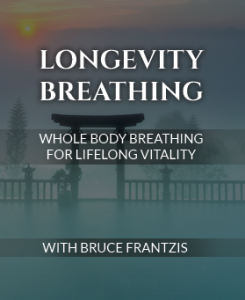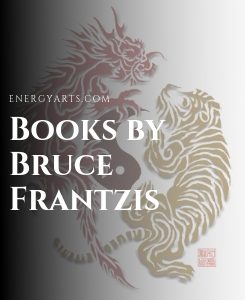Breathing is at the heart of Taoist arts and other Eastern practices, such as yoga and Buddhist meditation. Breathing well is also a key to success in Western athletic sports, including running, swimming, football and tennis.
Leading up to the Instructor Training this summer I’ll share a lot of important information about breathing to help you prepare. Whole-body breathing will make you feel more alive, improve your health and make your body conscious . . . bringing real value to your quality of life.
So in this first post I’ll talk about a classic Taoist phrase in the Inner Chapters, “The wise man breathes from his heels.” Well, if you haven’t got the faintest clue what Chuang Tzu means you’re not alone. Let’s explore some possibilities . . .
The Physiology of Whole-body Breathing
You begin by fully engaging your breathing mechanism to its highest capability. That is you breathe from your belly and the sides of your body, which engages your liver and spleen. Breathing from your belly also activates your diaphragm. You actually want to get your breath to move everything that’s below your abdominal muscles, including your intestines and all the parts involved with the digestive system.
You are effectively giving all of your internal organs a massage while oxygenating your blood. Where there is oxygen there is life: It has been shown, for example, that cancer simply cannot survive in highly oxygenated environments.
Of course whole-body breathing also includes opening up your lungs. This will apply pressure to your heart (in a good way) by supporting the muscles around the heart. When you get this going really well, then the breath in your belly will go all the way up into your brain, energizing your think-tank. For this to happen your glands must also be activated.
Going Deeper than the Physical Body
Whole-body breathing penetrates deeper than only the physical body. The wise man breathing from his heels says that if you breathe in and out of your feet, in that process you will have a sense of your breath going from your feet all the way through your entire body to the top of your head and out your fingertips.
The implication is that if you breathe from your heels you’ll draw on the earth’s energy. You can use that chi to open up the energy channels of your body. So you breathe not only from your physical body, but also in a manner that activates your etheric and other non-physical bodies. The Taoists have been practicing this technique pragmatically for thousands of years. It’s not a matter of creating a nice visualization.
You’ve probably heard the Taoist joke: You can visualize yourself walking like a duck and talking like a duck, but until you can lay an egg and feed a starving person you’re not a duck! So visualizations can be helpful, but actually activating energy flows is a different story. Taoists were not only able to demonstrate breathing from their heels, but teach people how to do it–24 hours a day.
In the West, breath training has really only been recognized as having a significant link to stress reduction and a greater sense of well-being, but that’s just the tip of the iceberg.
Opening the Energy Channels of Your Body
The Taoist phrase, “The wise man breathes from his heels,” is talking about the entirety of how you open up all the energy channels of your body. As you breathe in from your nose, you want to feel your breath in your entire body. This activates and increases blood circulation, which is critical to the transportation of vital nutrients and oxygen to and removal of waste products from every cell in your body. Whole-body breathing therefore has a positive systemic impact. Only breathing into the chest and upper lungs won’t cut it–no matter how hard you huff and puff.
Many people take Taoist practices as metaphor: I put my mind in my feet and breathe in and out and somehow I become healthier. In reality the process of genuine whole-body breathing starts in your belly, works its way up to your upper body, and then goes all the way to your finger tips and bottom of your feet.
If you are serious about qigong, bagua, tai chi, hsing-i, yoga, meditation–or your health in general–breathing will be at the core of each and every practice. If you truly learn to breathe from your heels just about anything is possible.




Awesome Master Bruce Frantzis.
Whole-body-breathing is also palpable
(although not at the bottom of the heel).
There are some acupuncture points where a pulse is palpable.
Some are huge, for example: Liver-12 “Urgent Pulse” and Spleen-12 “Rushing Gate” straddle the femorial artery at the kwa (groin).
Others are more difficult to feel, for example: Kidney-3 “Supreme Stream” and Bladder-60 “Kunlun Mountains” which are just above the heel.
See Ellis, “Grasping the Wind, An exploration into the meaning of Chinese acupuncture point names.”
Of course, acupuncturists use the pulses at both wrists to diagnose your health and the balance of Qi in your body. (It’s a complex art which pulpates 6 points at 3 levels each and 28 qualities.)
Dang, my Western Doctor now only uses one electronic cuff over the tip of a finger to measure blood pressure and pulse rate.
See Maciocia, “The Foundations of Chinese Mediciine.”
Practicing taiji I’m finding a correlation between these acupressure pulsation points and my breathing.
If you hold your breath the pulse hides.
Breathing has to be “just right” (the Goldilocks principle) to get one pulse point to resonant throughout your whole body. When everything is on the same frequency, the whole body joins to pulsate sympathetically. But the pulse can be obliterated by too much pressure. Too little pressure and you can’t find it. If you extend beyond the 70% rule, you get sucked in to a vortex which draws you away from your pulse.
“Tai Xi (Kidney-3, “Supreme Stream”) has the great strength and energy of a mountain stream stream flowing with force.” See Kaatz, “Characters of Wisdom, Taoist tales of the acupuncture points.”
This then becomes my pace and quality when doing taiji.
I sure wish I could join Bruce in Crete to study breathing further.
Thanks for sharing your cirruculum with us on the Internet.
bob
Post Falls, Idaho
Love the duck joke! Will remember that in my class. Looking forward to Crete also.
Something good being shared from Bruce Frantzis on the secrets of Taoist Longevity Breathing. It is explained in a simple language and would be really a great challenge to practice and experience.
Have a nice weekend!
Dear Bruce,
Thank you for these posts ! Am finding them very helpful and passing them along to friends who have enthusiastic responses (many have no prior experience with Taosit arts).
I have a couple of friends who are long-distance runners, one in particular playing with some basic Longevity Breathing exercises during his runs and is finding them very helpful – better run times. I’m used to working with this while still, or moving slowly, so I thought this was really interesting and it got me thinking. Was curious how the Taoists worked with these arts in vigorous exercise in past times (is this more in the martial or ba gua terrain?) and how it plays out now with modern extra-curricular cardio-vascular exercise, on the physical level, esp as there are lots of runners these days with warmer weather and marathon season here. As I read in this post, greater oxygenation & waste removal happens with LB – is it accurate to say LB create a smoother nervous system that will stay “smooth” as heart-rate increases ? or would it slow the heart rate in vigorous activity? or both? or something else? – curious about any additional info in this area.
Thank you again !
Katie
The aspect A wise man Breathes from the Heels, mentioned by master Bruce Frantzis in this article is felt by me , when I practiced with other master, that oriented me that you have to do breathing from your feet fingernails to the body to receive the energy; The difference is that master Bruce focus this subject with more details then others masters, That’s why I like now his method then others masters. I hope go to Crete but anyway I will make a propaganda to others people about the serminar. The problem is that Brasil is far away.
Ricardo Hercules de Azevedo Ursulino.
bruce
thanks for another extremely useful and practical blog. I love how you are really teaching things with the blog, not just giving your opinion on stuff.
I find a lot of use for the LB when I do bodywork.
generally, people don’t breathe well.
teaching just one or 2 of the basic elements of the breathing within a bodywork session really improves the outcome of the session, and it gives people more tools to manage their own health as well.
I also have used the songs of the tao CD, playing it during a session. (the breathing and alignments, songs only)
I see clients breathing better at the end of the session, whether or not I coached them on the breathing.
the first time I tried it, I just played the cd, no coaching, and I hadn’t taught the client breathing at all, and at the end, she commented on how well she was breathing, and you could see it; she was so much more energetically in balance and her breathing was really great, compared to before the session.
so thanks for doing so much for putting this stuff out there.
it’s making a big difference in my personal life, and my skills as a healer.
“HOPE ROCKS
FEAR SUCKS!”
I have two of your books the Energy gates book and Qigong. I think this is discussed briefly. I would like to know more and hopefully master this . Thanks
Hey! I know that this is very old post, but is there any possibility that You could give this kind of training again in closest time?
Very interesting! But I wonder what’s the meaning of the final part of chapter 55 of the Dao De Jing: “To force the breath strengthens, beings when strengthened get older, this is said contrary to Nature. What’s contrary to Nature ends soon.” Maybe this will help one to get stronger, but the excess of oxygen makes us old sooner (oxygen is a free radical which causes cell ageing).
Which book to choose ,i have anxiety that is getting worse, my diaphragm is so tight its disableing , i dont know what to do ,the antidepressants dont help .
Hi Juliaa, while we can’t diagnose or treat online, many of our practitioners have found that our Taoist Breathing Online Program helps loosen the diaphragm and relax the body. For a physical movement Practice, students have also found Dragon and Tiger Qigong a gentle and relaxing form that doesn’t over stimulate the body and furthers relaxation.